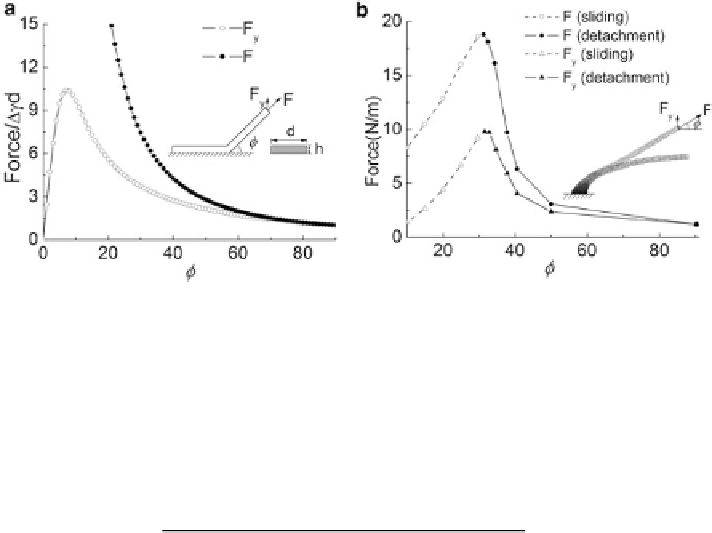Biomedical Engineering Reference
In-Depth Information
Fig. 10.8
Releasable adhesion in one-dimensional structures. Variation of the pull-off force as a
function of the pulling angle for (
a
) an elastic tape and (
b
) a single seta of gecko on a surface
(adapted, with permission, from [
7
])
q
ð
1
cos
2
F ¼ E
tp
hd
'Þ
þ
2
Dg=E
tp
h
ð
1
cos
'Þ
Dgd
ð
1
cos
2
¼
q
(10.23)
2
'Þ
þ
2
Dg=E
tp
h
þð
1
cos
'Þ
where
E
tp
denotes the Young's modulus of the tape;
h
and
d
stand for the thickness and
width of the tape, respectively. For a given elastic tape, (
10.23
) indicates that the peel-
off force varies with the pulling angle
Dg=E
tp
h ¼
10
4
(
01 J/m
2
,
E
tp
¼
1
:
0GPa,
h ¼
100 nm), Fig.
10.8a
plots the variation of the normalized peel-off
force and its projection normal to the contact interface as a function of the pulling
angle
'
. Taking
Dg ¼
0
:
. It is evident that the peel-off force varies strongly with the pulling angle.
[Note: Recently, Chen and Gao [
41
] have generalized Kendall's model to peeling of a
prestressed elastic tape on substrate, with results showing that a significantly large
prestress can cause spontaneous detachment at a critical angle, independent of the
magnitude of the peeling force. However, the role of prestress in reversible adhesion is
beyond the scope of this chapter and will not be discussed here.] Under the selected
parameter values, the normal projection of the peeling force exhibits a maximum
value around
'
'
7
.
10.4.2 Directional Adhesion Strength of a Single Seta
Autumn et al. [
2
] reported experimental data that the detachment force of a single
seta of gecko on a surface strongly depends on the orientation of pulling, with the
peak value achieved as the seta is pulled at an inclined angle of
' ¼
30
with respect

Search WWH ::

Custom Search